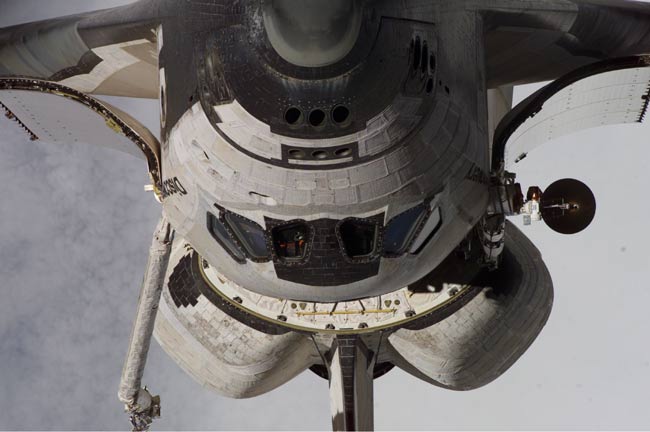Astronauts' Space Shuttle Inspection Slowed by Antenna Malfunction

Astronauts aboard NASA?s space shuttle Discovery scannedtheir spacecraft?s heat shield for any signs of damage on Tuesday, but couldn?tbeam the results to Mission Control because of a main antenna dish malfunction.
The antenna failed to work just after Discoverylaunched Monday on a delivery mission to the International Space Station. Withoutthe antenna, Discovery?s seven astronauts can?t send or receive big datapackages, like beaming live video to Mission Control or receiving majorrevisions to their flight plan.
?We can?t talk through it. We can?t send commands throughit. Really nothing works with it at this point,? shuttle flight directorRichard Jones said in a Tuesday morning briefing.
That meant Discovery?s astronauts had to record theresults of their shuttle inspection on 40-minute data tapes instead of beamingvideo and laser camera data straight to Mission Control. They had to use six tapes to store about 40 gigabytes of data from the inspection sothat it can be sent to Earth later once Discovery reaches the space station [Discovery?spre-dawn launch].
The astronauts used a 100-foot (30-meter) inspection boomtipped with laser sensors to scan the heat shield panels along Discovery?s wingedges and nose cap for any damage sustained during their Monday launch. ?Thesurvey took hours.
?It?s a long day so we actually rotate through,? said shuttlepilot Jim Dutton, one of three Discovery astronauts who performed the scan, ina NASA interview.
The inspection is a standard part of every space shuttlemission since the 2003 Columbia disaster, where wing heat shield damage ledto the loss of the spacecraft during re-entry. Seven astronauts were killed.
Get the Space.com Newsletter
Breaking space news, the latest updates on rocket launches, skywatching events and more!
Since then, NASA has developed rigorous inspectiontechniques and repair methods to ensure heat shield integrity of its shuttlesin flight. Tuesday?s inspection is the first of three planned surveys of theshuttle by its crew and astronauts on the space station.
Discovery is due to dock at the International SpaceStation Wednesday morning at 3:44 a.m. EDT (0744 GMT). The astronauts areworking on a skewed schedule that requires them to sleep in the day and work atnight. They?ll go to sleep at about 12:21 p.m. EDT (1621 GMT) today to rest upahead of Wednesday?s docking.
The malfunctioning Ku-band antenna dish is 3 feet (1meter) wide and about 7 feet (2.1 meters) long. It is one of severalcommunication systems on Discovery, which also has UHF and S-band systems forvoice and data transmission, but only the Ku-band system can send home video.
Without the antenna, Discovery?s rendezvous with thespace station is expected to be a bit trickier, since the device is also usedin a radar mode to give shuttle commander Alan Poindexter updates on Discovery?sapproach and alignment.
Jones said the astronauts can use star trackers and otherdevices in place of the antenna?s radar.
Jones said that the antenna is tracking communicationssatellites in orbit, just not sending or receiving information. A similarantenna failure occurred during NASA?s STS-92shuttle mission to the space station in 2000, he added.
It is unclear if the antenna can be repaired duringDiscovery?s 13-day mission. But so far, the glitch has not posed too much of aproblem for Discovery?s crew or flight controllers on Earth, Jones said.
?I would characterize it right now as a minorinconvenience,? Jones said.
- Images- Shuttle Discovery?s Stunning Pre-dawn Launch
- NASA'sMost Memorable Space Missions
- SpottingSpaceships From Earth
SPACE.comis providing complete coverage of Discovery's STS-131 mission to theInternational Space Station with Managing Editor Tariq Malik and Staff Writer Clara Moskowitz based in New York. Click here for shuttle missionupdates and a link to NASA TV.
Join our Space Forums to keep talking space on the latest missions, night sky and more! And if you have a news tip, correction or comment, let us know at: community@space.com.

Tariq is the Editor-in-Chief of Space.com and joined the team in 2001, first as an intern and staff writer, and later as an editor. He covers human spaceflight, exploration and space science, as well as skywatching and entertainment. He became Space.com's Managing Editor in 2009 and Editor-in-Chief in 2019. Before joining Space.com, Tariq was a staff reporter for The Los Angeles Times covering education and city beats in La Habra, Fullerton and Huntington Beach. In October 2022, Tariq received the Harry Kolcum Award for excellence in space reporting from the National Space Club Florida Committee. He is also an Eagle Scout (yes, he has the Space Exploration merit badge) and went to Space Camp four times as a kid and a fifth time as an adult. He has journalism degrees from the University of Southern California and New York University. You can find Tariq at Space.com and as the co-host to the This Week In Space podcast with space historian Rod Pyle on the TWiT network. To see his latest project, you can follow Tariq on Twitter @tariqjmalik.









